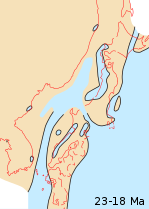Geology of Japan
The islands of
Japan was originally attached to the eastern coast of the Eurasian continent. The subducting plates, being deeper than the Eurasian plate, pulled Japan eastward in the process of back-arc extension, opening the Sea of Japan around 15 million years ago.[1] The Strait of Tartary and the Korea Strait opened much later.
Japan is situated in a

Geological history
Orogeny phase

The breakup of
Island arc phase
Around 23 million years ago, western Japan was a coastal region of the Eurasia continent. The subducting plates, being deeper than the Eurasian plate, pulled parts of Japan which become modern
-
Japanese archipelago, Sea of Japan and surrounding part of continental East Asia in Early Miocene (23-18 Ma)
-
Japanese archipelago, Sea of Japan and surrounding part of continental East Asia inLate Pliocene(3.5-2 Ma)
-
Japanese archipelago at the Last Glacial Maximum about 20,000 years ago, thin black line indicates present-day shorelinesVegetated landUnvegetated landOcean
Current state
General information
Overall, the geological composition of Japan is poorly understood. The Japanese islands are formed of several geological units parallel to the subduction front. The parts of islands facing oceanic plates are typically younger and display a larger proportion of volcanic products, while the parts facing the Sea of Japan are mostly heavily faulted and folded sedimentary deposits. In north-west Japan, the thick quaternary deposits make determination of the geological history especially difficult.[6]
Geological structure
The Japanese islands are divided into three major geological domains:
- Northeastern Japan, north of Tanakura fault (which had high volcanic activity 14-17 million years before present[7])
- Central Japan, between Tanakura fault and Itoigawa-Shizuoka Tectonic Line.
- Southwestern Japan, south of accretionary complexes of Jurassicperiod or younger.
- Urasoko fault
- Fukozu Fault
- Neodani Fault
- Nojima Fault
- Hida orogenic belt (Hida Mountains and Ryōhaku Mountains)
- Sangun orogenic belt
- Maizuru orogenic belt
- Tanba-mino orogenic belt
- Ryoke orogenic belt
- Shimanto orogenic belt[9]
- Sambagawa orogenic belt[10]
- Chichibu orogenic belt[11]
- Sambosan orogenic belt
- Beppu–Shimabara graben
Research
The Geology of Japan is handled mostly by Geological Society of Japan, with the following major periodicals:
- The Journal of the Geological Society of Japan - since 1893
- Geological Studies (地質学論集) - since 1968
- Geological Society of Japan News (日本地質学会News) - since 1998
Geological hazards
Japan is in a volcanic zone on the Pacific Ring of Fire. Frequent low intensity earth tremors and occasional volcanic activity are felt throughout the islands. Destructive earthquakes, often resulting in tsunamis, occur several times a century. The most recent major quakes include the 2011 Tōhoku earthquake and tsunami, the 2004 Chūetsu earthquake and the Great Hanshin earthquake of 1995.
See also
- Geography of Japan
- Seismicity in Japan
- List of earthquakes in Japan
- List of volcanoes in Japan
- List of mines in Japan
References
- University of Durham. Archived from the original(PDF) on April 28, 2011. Retrieved August 11, 2009.
- ISSN 1367-9120.
- S2CID 129989718. Archived from the original(PDF) on August 9, 2017. Retrieved October 10, 2017.
- University of Durham. Archived from the original(PDF) on April 28, 2011. Retrieved August 11, 2009.
- ^ "Formation history of the Japanese Islands (4) -- GLGArcs". glgarcs.rgr.jp. Archived from the original on December 1, 2017. Retrieved July 16, 2017.
- ^ "Geology of Japan|Geological Survey of Japan, AIST|産総研地質調査総合センター / Geological Survey of Japan, AIST". gsj.jp. Retrieved July 16, 2017.
- ^ "Yurie SAWAHATA, Makoto Okada, Jun Hosoi, Kazuo Amano, "Paleomagnetic study of Neogene sediments in strike-slip basins along the Tanakura Fault". confit.atlas.jp. Retrieved July 16, 2017.
- ^ [email protected]. "Southwest Japan". geo.arizona.edu. Archived from the original on October 10, 2017. Retrieved July 16, 2017.
- ^ A. Taira, H. Okada, J. H. McD. Whitaker & A. J. Smith, The Shimanto Belt of Japan: Cretaceous-lower Miocene active-margin sedimentation
- ^ "Sanbagawa belt (Sambagawa metamorphic belt), Shikoku Island, Japan". mindat.org. Retrieved July 16, 2017.
- ^ "Chichibu belt from geo.arizona.edu". geo.arizona.edu. Archived from the original on December 5, 2017. Retrieved July 16, 2017.
Further reading
- Hashimoto, M., ed. (1990). Geology of Japan. Dordrecht: Kluwer Academic Publishers. ISBN 9780792309093.
- T. Moreno; S.R. Wallis; T. Kojima; W. Gibbons, eds. (16 March 2016). Geology of Japan (Geological Society of London)(2015). ISBN 978-1862397439.
by - (Author),
- Takai, Fuyuji; Tatsurō Matsumoto; Ryūzō Toriyama (1963). Geology of Japan. University of California Press.
External links
| External image | |
|---|---|
- National Archives of Japan: Tatoroyama no ki, survey of limestone cave in Mount Tatoro in Kozuke Province, 1837 (Tenpo 8).



